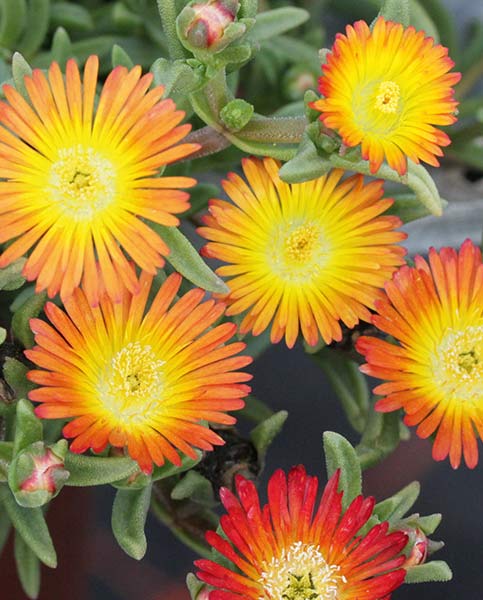How to grow Vitis (Grape)
Vitis is a genus of vine plants from the Vitaceae family. Reaching extraordinary heights of 15m and 4m in spread, Vitis are avid climbing shrubs with vigorous tendrils that can be grown indoors or outdoors. You may think that it is not possible to grow grapes in UK gardens, however, the Royal Horticultural Society (RHS) has awarded the cultivar Vitis vinifera purpurea their Award of Garden Merit - perfect for growing under UK conditions.
One of the best things about Vitis is the delicious fruit that comes straight after the small green flowers each year - fresh edible grapes grow from the successfully pollinated flowers. You can use these grapes at home for eating, adding to dishes or even fermenting into wine.
With great historical significance, Vitis has been mentioned as far back as the bible and it is interesting that no fruit is mentioned more than the grape and its products - including wine! Taking 2-5 years to reach full maturity, Vitis will need care, attention and specific training to produce fruit. By autumn you will be rewarded with beautiful displays of hanging grapes.

Key Information
Soil pH
Position
Hardiness


Where & when to plant Vitis
Plant Vitis in the early spring for the best results. Your chosen position also needs deep soil that drains well - chalk, clay, sand or loam can support this providing they are not waterlogged. As Vitis is an avid climber, choose walls, side borders, trellis, fences or sturdy pergolas to plant next to - you will want to grow the plant 15cm away from this structure initially.
How to plant Vitis
Start by selecting an area to grow Vitis which enjoys deep, well-drained soil and full sun (6-8 hours of sunlight daily)
Whether you are growing from bare root or pots, give each Vitis plant at least 1.5m of space to grow between other plants
Add a thin layer of well-rotted manure and compost to your desired spot. Dig a hole twice as wide and deep as the root ball – place the plant in the hole and backfill, watering in thoroughly to settle the plant
In the spring, you can add fertiliser to the base of Vitis to support healthy growth

What to plant with Vitis
When it comes to grapevines, you should choose neighbouring plants wisely. An easy choice is to select natural pest-repellents whose fragrances will ward off any pests such as garlic (Tulbaghia), mint or thyme (Thymus). Perhaps the best selection is hyssop - this has both pest-deterrent properties and the ability to improve the flavour of your grapes. Each of these choices adds colour and fragrance to your garden while supporting the healthy growth of your Vitis.



How to care for Vitis
Pruning & Deadheading
Interestingly, grapes have their own systems for pruning. For Vitis, we suggest the ‘rod and spur’ pruning system, which is suited to grow grapevines outdoors against walls. This includes pruning side branches and tying the main stems up in the first year, followed by cutting back the main stem by two-thirds in the first year. This plan continues on for the next three years and will help you to successfully train your Vitis while keeping it healthy and neat.
Watering
Deep and regular watering in dry weather. In summer you will notice the grapes swell - while the grapevine needs watering, be gentle to avoid the fruits splitting. Once established, water less frequently in the winter.
Cold Protection
Some species of Vitis are hardy down to temperatures of -10°C and will go dormant - you may see a wax form - which is a natural protective covering. In spring, you can mulch and add a layer of woodchips to help with weed-suppression. This will last through the summer to keep the grapevine soil cool and nourished. Ideally, try to keep Vitis outside so it does not bloom too early.
Pests & Diseases
Vitis plants are susceptible to some common UK diseases such as powdery mildew, botrytis and root rot. Powdery mildew and botrytis both stem from fungus and appear as white powdery fungal spots or grey mould on the foliage and will need treating with a proprietary spray. Root rot is also a concern although it is preventable. Ensure that your Vitis plant has well-draining soil and is not overwatered to avoid root rot.
How to propagate Vitis
The best way to propagate Vitis is by taking hardwood cuttings. Take these in the autumn while the plant is dormant
Using clean and sterilised sharp tools, take pencil-width cuttings from healthy stems that are 60cm in length. Take each cutting from just above a leaf joint and add each cutting to water once taken to reduce moisture loss
Trim your 60cm cutting into several shorter 15cm stems with at least two sets of leaves on each. Create slanted cuts on the bottom of each to support water absorption and differentiate the bottom of the cutting from the top. This will allow you to re-pot your cutting the right way up!
Add each cutting to a pot of cuttings compost and use a pencil to create small, deep holes - perfect for placing a cutting in. Leave 2-3 buds from each cutting above the soil line, firm the compost around the cutting and water in. Place a plastic or polythene bag over each cutting pot to create humidity and water once a week until each cutting is ready for potting on or planting out.
Common Vitis Questions
Can you eat Vitis grapes?
Yes! Vitis grapes grow as a result of pollinated flowers on the grapevine and, although they might taste quite sweet or sharp straight from the vine, they are edible.
What should you grow with Vitis?
With Vitis, you should grow fragrant herbs that deter pests and aid the growth of your grapevine. Good examples of this are thymus, tulbhagia (Garlic), mint and hyssop.
When is the best time to plant Vitis?
Plant Vitis between autumn and spring for the best results.





